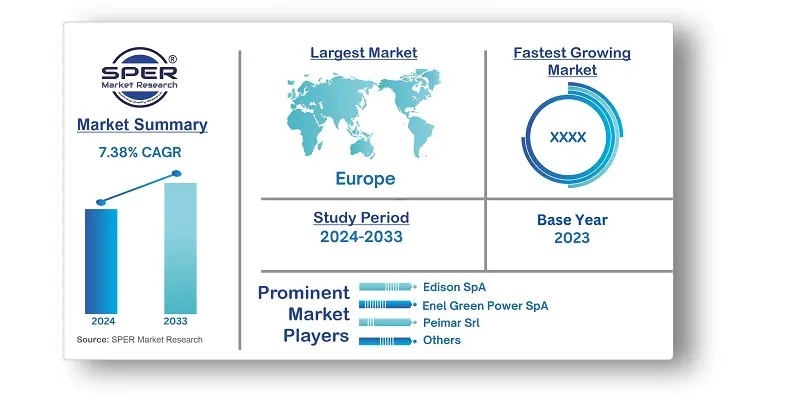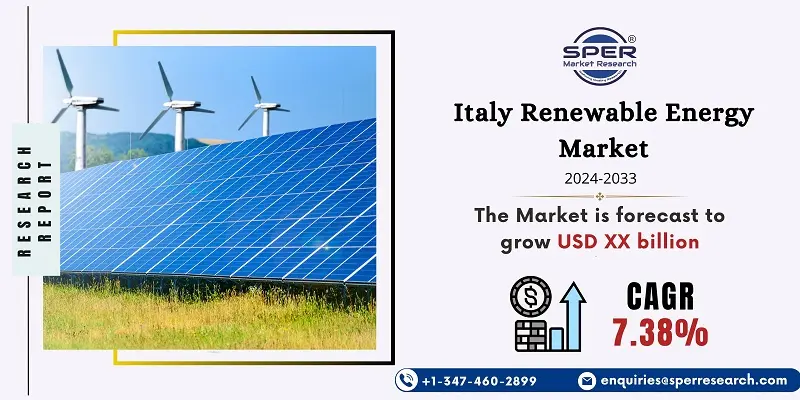
Italy Renewable Energy Market Growth, Size, Trends, Share, Revenue, Demand and Future Outlook
Italy Renewable Energy Market Size- By Type- Regional Outlook, Competitive Strategies and Segment Forecast to 2033
| Published: Jul-2024 | Report ID: POAE2456 | Pages: 1 - 108 | Formats*: |
| Category : Power & Energy | |||
- An independent power producer firm (IPP), BNZ, declared in December 2021 that it had been granted permission to build a 45 MW solar PV facility in the Italian province of Lazio. The project should be operational by 2023, according to the developer.
- RWE's Italian renewable energy business started up at its new onshore wind farm, Alcamo II, in Sicily in April 2021. This project is RWE's first international partnership with Goldwind. The four turbines (GW 136-3.4MW) were supplied by Goldwind, and together they have an installed capacity of 13.6 megawatts (MW), producing 26 gigawatt-hours of power annually.


| Report Metric | Details |
| Market size available for years | 2020-2033 |
| Base year considered | 2023 |
| Forecast period | 2024-2033 |
| Segments covered | By Type |
| Regions covered | Eastern, Western, Southern, Northern |
| Companies Covered | Edison SpA, EF Solare Italia SpA, Enel Green Power SpA, ERG SpA, Gruppo STG Srl, Peimar Srl, Siemens Gamesa Renewable Energy SA, Vestas Wind Systems AS, Others. |
- Government and Regulatory Bodies
- Energy Utilities and Grid Operators
- Renewable Energy Developers and Project Managers
- Financial Institutions and Investors
- Technology Providers and Equipment Manufacturers
- Academic and Research Institutions
- Environmental NGOs and Advocacy Groups
| By Type: |
|
- Italy Renewable Energy Market Size (FY’2024-FY’2033)
- Overview of Italy Renewable Energy Market
- Segmentation of Italy Renewable Energy Market By Type (Solar, Wind, Hydro, Others)
- Expansion Analysis of Italy Renewable Energy Market
- Problems and Obstacles in Italy Renewable Energy Market
- Competitive Landscape in the Italy Renewable Energy Market
- Impact of COVID-19 and Demonetization on Italy Renewable Energy Market
- Details on Current Investment in Italy Renewable Energy Market
- Competitive Analysis of Italy Renewable Energy Market
- Prominent Players in the Italy Renewable Energy Market
- SWOT Analysis of Italy Renewable Energy Market
- Italy Renewable Energy Market Future Outlook and Projections (FY’2024-FY’2033)
- Recommendations from Analyst
1.1. Scope of the report1.2. Market segment analysis
2.1. Research data source
2.1.1. Secondary Data2.1.2. Primary Data2.1.3. SPER’s internal database2.1.4. Premium insight from KOL’s
2.2. Market size estimation
2.2.1. Top-down and Bottom-up approach
2.3. Data triangulation
4.1. Driver, Restraint, Opportunity and Challenges analysis
4.1.1. Drivers4.1.2. Restraints4.1.3. Opportunities4.1.4. Challenges
4.2. COVID-19 Impacts of the Italy Renewable Energy Market
5.1. SWOT Analysis
5.1.1. Strengths5.1.2. Weaknesses5.1.3. Opportunities5.1.4. Threats
5.2. PESTEL Analysis
5.2.1. Political Landscape5.2.2. Economic Landscape5.2.3. Social Landscape5.2.4. Technological Landscape5.2.5. Environmental Landscape5.2.6. Legal Landscape
5.3. PORTER’s Five Forces
5.3.1. Bargaining power of suppliers5.3.2. Bargaining power of buyers5.3.3. Threat of Substitute5.3.4. Threat of new entrant5.3.5. Competitive rivalry
5.4. Heat Map Analysis
6.1. Italy Renewable Energy Market Manufacturing Base Distribution, Sales Area, Product Type6.2. Mergers & Acquisitions, Partnerships, Product Launch, and Collaboration in Italy Renewable Energy Market
7.1. Italy Renewable Energy Market Size, Share and Forecast, By Type, 2020-20267.2. Italy Renewable Energy Market Size, Share and Forecast, By Type, 2027-20337.3. Solar7.4. Wind7.5. Hydro7.6. Others
8.1. Italy Renewable Energy Market Size and Market Share
9.1. Italy Renewable Energy Market Size and Market Share By Region (2020-2026)9.2. Italy Renewable Energy Market Size and Market Share By Region (2027-2033)9.3. Eastern9.4. Western9.5. Southern9.6. Northern
10.1. Edison SpA
10.1.1. Company details10.1.2. Financial outlook10.1.3. Product summary10.1.4. Recent developments
10.2. EF Solare Italia SpA
10.2.1. Company details10.2.2. Financial outlook10.2.3. Product summary10.2.4. Recent developments
10.3. Enel Green Power SpA
10.3.1. Company details10.3.2. Financial outlook10.3.3. Product summary10.3.4. Recent developments
10.4. ERG SpA
10.4.1. Company details10.4.2. Financial outlook10.4.3. Product summary10.4.4. Recent developments
10.5. Gruppo STG Srl
10.5.1. Company details10.5.2. Financial outlook10.5.3. Product summary10.5.4. Recent developments
10.6. Peimar Srl
10.6.1. Company details10.6.2. Financial outlook10.6.3. Product summary10.6.4. Recent developments
10.7. Siemens Gamesa Renewable Energy SA
10.7.1. Company details10.7.2. Financial outlook10.7.3. Product summary10.7.4. Recent developments
10.8. Vestas Wind Systems AS
10.8.1. Company details10.8.2. Financial outlook10.8.3. Product summary10.8.4. Recent developments
10.9. Others
SPER Market Research’s methodology uses great emphasis on primary research to ensure that the market intelligence insights are up to date, reliable and accurate. Primary interviews are done with players involved in each phase of a supply chain to analyze the market forecasting. The secondary research method is used to help you fully understand how the future markets and the spending patterns look likes.
The report is based on in-depth qualitative and quantitative analysis of the Product Market. The quantitative analysis involves the application of various projection and sampling techniques. The qualitative analysis involves primary interviews, surveys, and vendor briefings. The data gathered as a result of these processes are validated through experts opinion. Our research methodology entails an ideal mixture of primary and secondary initiatives.



Frequently Asked Questions About This Report
PLACE AN ORDER
Year End Discount
Sample Report
Pre-Purchase Inquiry
NEED CUSTOMIZATION?
Request CustomizationCALL OR EMAIL US
100% Secure Payment






Related Reports
Our Global Clients
Our data-driven insights have influenced the strategy of 200+ reputed companies across the globe.






















